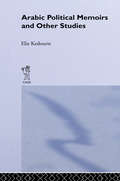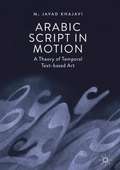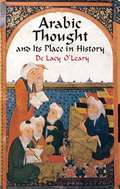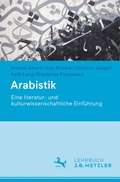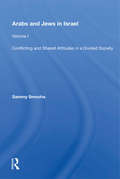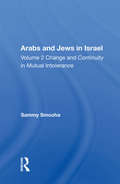- Table View
- List View
The Arabic Historical Tradition & the Early Islamic Conquests: Folklore, Tribal Lore, Holy War
by Boaz ShoshanThe early Arab conquests pose a considerable challenge to modern-day historians. The earliest historical written tradition emerges only after the second half of the eighth century- over one hundred years removed from the events it contends to describe, and was undoubtedly influenced by the motives and interpretations of its authors. Indeed, when speaking or writing about the past, fact was not the only, nor even the prime, concern of Muslims of old. The Arabic Historic Tradition and the Early Islamic Conquests presents a thorough examination of Arabic narratives on the early Islamic conquests. It uncovers the influence of contemporary ideology, examining recurring fictive motifs and evaluating the reasons behind their use. Folklore and tribal traditions are evident throughout the narratives, which aimed to promote individual, tribal and regional fame through describing military prowess in the battles for the spread of Islam. Common tropes are encountered across the materials, which all serve a central theme; the moral superiority of the Muslims, which destined them to victory in God’s plan. Offering a key to the state of mind and agenda of early Muslim writers, this critical reading of Arabic texts would be of great interest to students and scholars of early Arabic History and Literature, as well as a general resource for Middle Eastern History.
The Arabic Historical Tradition & the Early Islamic Conquests: Folklore, Tribal Lore, Holy War
by Boaz ShoshanThe early Arab conquests pose a considerable challenge to modern-day historians. The earliest historical written tradition emerges only after the second half of the eighth century- over one hundred years removed from the events it contends to describe, and was undoubtedly influenced by the motives and interpretations of its authors. Indeed, when speaking or writing about the past, fact was not the only, nor even the prime, concern of Muslims of old. The Arabic Historic Tradition and the Early Islamic Conquests presents a thorough examination of Arabic narratives on the early Islamic conquests. It uncovers the influence of contemporary ideology, examining recurring fictive motifs and evaluating the reasons behind their use. Folklore and tribal traditions are evident throughout the narratives, which aimed to promote individual, tribal and regional fame through describing military prowess in the battles for the spread of Islam. Common tropes are encountered across the materials, which all serve a central theme; the moral superiority of the Muslims, which destined them to victory in God’s plan. Offering a key to the state of mind and agenda of early Muslim writers, this critical reading of Arabic texts would be of great interest to students and scholars of early Arabic History and Literature, as well as a general resource for Middle Eastern History.
The Arabic Language Today (Routledge Library Editions: Language & Literature of the Middle East)
by A.F.L. BeestonThis book, first published in 1970, provides a description of the standard Arabic language used today as the universal means of written communication throughout the Arab world and in formal spoken communication (vernaculars differ both from each other and from the standard language). The principal emphasis is on syntax and morphology of which there exists no comprehensive account. Phonology and lexicon are treated briefly and there is a chapter on the script.
The Arabic Language Today (Routledge Library Editions: Language & Literature of the Middle East)
by A.F.L. BeestonThis book, first published in 1970, provides a description of the standard Arabic language used today as the universal means of written communication throughout the Arab world and in formal spoken communication (vernaculars differ both from each other and from the standard language). The principal emphasis is on syntax and morphology of which there exists no comprehensive account. Phonology and lexicon are treated briefly and there is a chapter on the script.
The Arabic Linguistic Tradition (Routledge Library Editions: Language & Literature of the Middle East)
by Georges Bohas Jean-Patrick Guillaume Djamel Eddine KouloughliThe importance and richness of the Arabic linguistic tradition, largely neglected by Western literature, is amply demonstrated by this book, first published in 1990. Written by three experts in the field, it provides us with a comprehensive survey of the historical constitution and theoretical structure of the Arabic linguistic tradition from its beginnings in the eighth century to its mature state around the fourteenth and fifteenth centuries. Besides grammar, the book covers such fields as rhetoric, grammatical semantics, and methodological issues, and pays particular attention to the most representative works of the classical period. It also has the unique benefit of containing the historical background.
The Arabic Linguistic Tradition (Routledge Library Editions: Language & Literature of the Middle East)
by Georges Bohas Jean-Patrick Guillaume Djamel Eddine KouloughliThe importance and richness of the Arabic linguistic tradition, largely neglected by Western literature, is amply demonstrated by this book, first published in 1990. Written by three experts in the field, it provides us with a comprehensive survey of the historical constitution and theoretical structure of the Arabic linguistic tradition from its beginnings in the eighth century to its mature state around the fourteenth and fifteenth centuries. Besides grammar, the book covers such fields as rhetoric, grammatical semantics, and methodological issues, and pays particular attention to the most representative works of the classical period. It also has the unique benefit of containing the historical background.
Arabic Media Coverage of Pandemics: Discourse, Strategy and Impact (Routledge Studies in Middle East Film and Media)
by El Mustapha LahlaliFocused on two networks, Al-Jazeera and BBC Arabic, this study provides an in-depth quantitative and qualitative analysis of different media strategies employed in the coverage of Covid-19. The author draws primarily from Critical Discourse Analysis, supplemented by an analysis of corpora from both Al-Jazeera and BBC, comprising news items, documentaries and discussion shows. An array of key topics are examined for their language and lexis, including political leaders and governments, the public and victims of Covid-19. The two networks’ coverage of these topics are closely compared and contrasted, with both employing strategies of exemplification, nominalisation, functionalisation, naming and labelling. The analysis shows that the two networks have displayed a solidarity discourse throughout the pandemic, emphasising the need to fight the disease. In addition, the networks have consistently stressed the gravity of the pandemic, urging adherence to local regulations. It is ultimately argued that examining the coverage of Covid-19 from a dialectical perspective will enable us to unravel the social, cultural, political, and ideological motives behind the production of pandemic media discourse. The book will appeal to students and researchers in linguistics, media and communications, and Middle Eastern studies, as well as to general readers interested in conflict and pandemic response.
Arabic Media Coverage of Pandemics: Discourse, Strategy and Impact (Routledge Studies in Middle East Film and Media)
by El Mustapha LahlaliFocused on two networks, Al-Jazeera and BBC Arabic, this study provides an in-depth quantitative and qualitative analysis of different media strategies employed in the coverage of Covid-19. The author draws primarily from Critical Discourse Analysis, supplemented by an analysis of corpora from both Al-Jazeera and BBC, comprising news items, documentaries and discussion shows. An array of key topics are examined for their language and lexis, including political leaders and governments, the public and victims of Covid-19. The two networks’ coverage of these topics are closely compared and contrasted, with both employing strategies of exemplification, nominalisation, functionalisation, naming and labelling. The analysis shows that the two networks have displayed a solidarity discourse throughout the pandemic, emphasising the need to fight the disease. In addition, the networks have consistently stressed the gravity of the pandemic, urging adherence to local regulations. It is ultimately argued that examining the coverage of Covid-19 from a dialectical perspective will enable us to unravel the social, cultural, political, and ideological motives behind the production of pandemic media discourse. The book will appeal to students and researchers in linguistics, media and communications, and Middle Eastern studies, as well as to general readers interested in conflict and pandemic response.
Arabic Political Memoirs and Other Studies
by Elie KedourieFirst Published in 2005. Routledge is an imprint of Taylor & Francis, an informa company.
Arabic Political Memoirs and Other Studies
by Elie KedourieFirst Published in 2005. Routledge is an imprint of Taylor & Francis, an informa company.
Arabic Proverbs: The Manners and Customs of the Modern Egyptians
by J. L. BurckhardtCompleted just before his death in 1817 by one of the foremost European pioneers in Arabic studies. Reprint with Introduction by C.E. Bosworth.
Arabic Proverbs: The Manners and Customs of the Modern Egyptians (Cambridge Library Collection - Travel, Middle East And Asia Minor Ser.)
by J. L. BurckhardtCompleted just before his death in 1817 by one of the foremost European pioneers in Arabic studies. Reprint with Introduction by C.E. Bosworth.
Arabic Script in Motion: A Theory of Temporal Text-based Art
by M. Javad KhajaviThis book is a pioneering study of temporal typography and time-based calligraphic art written in the Arabic system of writing. Inspired by the innate qualities of Arabic script as well as certain practices in Islamic calligraphy and contemporary calligraphic art, the book devises five broad categories of temporal behaviors for Arabic characters in time-based media. It goes onto expand the vocabulary used to describe Arabic script’s appearance in time-based media and proposes a theory to help artists, practitioners, and theoreticians push the boundaries of temporal text-based art. Furthermore, it tackles questions of legibility and readability, and seeks to understand how temporality of Arabic text influences the creation of meaning. This book will therefore appeal not only to animators, designers, and artists, but also to commentators and scholars who deal with temporal text-based art written in Arabic script.
Arabic Thought and Its Place in History
by De Lacy O'LearyWell-documented study of the mutual influence of Arabic and Western worlds during the Middle Ages traces the transmission of Greek philosophy and science to the Islamic cultures. A fascinating portrait of medieval Muslim thought, it illustrates commonalities with Judaic and Christian teachings as well as points of divergence.
Arabien: Mehr als Erdöl und Konflikte (Politisches Streiflicht)
by Udo SteinbachDie Araber und die "Arabische Welt" begegnen uns nahezu täglich - in ganz unterschiedlichen Zusammenhängen - in den Medien. Gegenstand und Anlaß der Berichterstattung freilich sind zumeist wenig erfreulich. Das hat viele Gründe. Einer ist in der Tht das schwere Erbe, das die Geschichte den Arabern hinterlassen hat: erst die Herrschaft des Os manischen Reiches, später die anderthalb Jahrhunderte dauernde Dominanz Europas. Ein anderer Grund liegt naturgemäß in den Ara bern selbst. Vergleichen mit anderen Teilen der nicht-europäischen (im weitesten Sinne) Welt tun sie sich schwer, die Gegebenheiten und Erfordernisse der Modeme anzunehmen und mitzugestalten. Ein dritter Grund aber liegt in unserem eingeschränkten Wahrneh mungsvermögen in einer Zeit, in der vornehmlich negative Sensatio nen, vermittelt in den Medien, eine breite Öffentlichkeit unter halten. In unseren Thgen, in der die Welt so rasch zusammenwächst, in der Schranken fallen und neue Formen vielseitiger Zusammenarbeit ent stehen, sollten wir uns eine solche Fremdheit nicht mehr leisten. Das hier vorgelegte Bändchen soll deshalb ein wirklichkeitsnahes Bild der Araber und ihrer "Welt" vermitteln. Es soll helfen, Fremdheit zu überwinden. Nach der Durchsicht der zumeist kurzen Beiträge soll der Leser das Gefühl haben, etwas mehr von der "arabischen Welt", ihren Menschen und Problemen, aber auch ihren Bemühungen, in dieser Welt einen Platz zu finden, zu verstehen, als dies ihm aus der laufenden Berichterstattung möglich ist.
Arabisch-Amerikanische Jugend: Diskriminierung, Entwicklung, Bildungspraxis und -politik
by Rhonda TabbahDieses Buch untersucht die Auswirkungen der Diskriminierung arabisch-amerikanischer Jugendlicher mit Schwerpunkt auf den K-12-Schulsystemen. Es beginnt mit einer Einführung in die arabisch-amerikanische Jugend und ihre Erfahrungen im Bildungssystem. Es folgt ein Überblick über die historischen Beiträge zur Diskriminierung und die Geschichte der Diskriminierung von Arabern in Amerika, einschließlich des Bildungssystems. Anschließend werden relevante theoretische Perspektiven zu Diskriminierung und Entwicklungsprozessen vorgestellt. Das Buch untersucht Forschungsergebnisse, die sich speziell auf arabisch-amerikanische Jugendliche beziehen, zeigt die Grenzen der Forschung auf und bietet Strategien zur Stärkung der methodischen Ansätze, um Forschung, Praxis und Politik besser zu informieren. Abschließend werden Strategien zur Verbesserung der Bildungspraxis und -politik sowie Empfehlungen für Interventionen zur Förderung der Entwicklungsgesundheit arabisch-amerikanischer Jugendlicher in Schulen gegeben.Zu den wichtigsten Themenbereichen gehören:· Arabisch-amerikanische Jugend, Entwicklung und Diskriminierung in Amerika.· Diskriminierung im K-12-Bildungssystem.· Selbstkonzept, ethnische Identität, Wohlbefinden und Diskriminierung unter arabisch-amerikanischen Jugendlichen.Arab American Youth ist ein unverzichtbares Hilfsmittel für Praktiker, Forscher, Pädagogen und andere Fachleute sowie für Studenten der Schulpsychologie, der pädagogischen Psychologie, der Pädagogik und verwandter Disziplinen.Dr. Tabbah hat ein Buch geschrieben, das längst überfällig ist ... Sie liefert einen Entwurf für Fortschritte im Bildungswesen und in der politischen Entwicklung, die für die arabisch-amerikanische Jugend von Bedeutung sein können.Antoinette Miranda, Professorin für Schulpsychologie, The Ohio State UniversityDieses Buch ist ein wertvoller Beitrag angesichts der erst im Entstehen begriffenen Literatur über die Erfahrungen arabischer Jugendlicher und die erheblichen Auswirkungen von Diskriminierung auf ihre Schulbildung.Desiree Vega, Außerordentliche Professorin für Schulpsychologie, Universität von Arizona
Arabischer Frühling?: Alte und neue Geschlechterpolitiken in einer Region im Umbruch (Feministisches Forum #5)
by Dagmar Filter Jana Reich Eva FuchsDer Band befasst sich mit der Frage nach der politischen und gesellschaftlichen Partizipation von Frauen und Männern in muslimischen Gesellschaften vor, während und nach dem Arabischen Frühling, sowie der Bedeutung von Geschlechter(de)konstruktionen in einer Gesellschaft im Wandel.In den meisten Ländern des "Arabischen Frühlings" sind die Geschlechterverhältnisse durch eine patriarchale Struktur und Tradition geprägt, die besonders Frauen in ihrer persönlichen Freiheit und in ihrer politischen Mitbestimmung einschränkt. Die revolutionären Prozesse in diesen Gesellschaften bieten die Chance, die Geschlechterverhältnisse aufzubrechen, neu zu denken und zu verhandeln. Die Selbstbefreiung der arabischen Frauen kann nicht automatisch durch die aktuellen revolutionären Veränderungen gelingen. Dennoch wohnt Revolutionen ein utopisches Potential inne, das durch keine konterrevolutionären Maßnahmen aufgehalten werden kann. Zwischen revolutionärer Wirklichkeit und inspirierter Utopie geht der Kampf um die Selbstbefreiung der Frauen (und der Männer) in der arabischen Welt weiter.
The Arab–Israeli Conflict, 1956–1975: From Violent Conflict to a Peace Process (Israeli History, Politics and Society)
by Moshe GatThe Arab–Israeli Conflict, 1956–1975 contains a collection of articles that examine select issues between the end of the Suez Campaign in November 1956 and the Sinai II, or Interim Agreement, signed by Israel and Egypt in September 1975. The book provides a comprehensive overview of the struggle between the three superpowers – the UK, the United States and the Soviet Union – and the effects this had on the region. It also explores the circumstances that led to the Six Day War in June 1967, such as the use of air power and the Israeli retaliatory raids. Two chapters look at the two leaders during the war: Egyptian President Gamal Abdel Nasser, leader of the Arab world – a charismatic and dominant persona – and Israeli Prime Minister Levi Eshkol, considered weak and inconspicuous. Three chapters focus on the period between the two wars – June 1967 and October 1973 – and one explores the aftermath. Emphasis is placed on Israeli policy between 1967 and 1973, which primarily focused on the use of military power and foreign policy inaction. It is argued that it was this policy that hindered all progress in the peace process, and ultimately led, among other factors, to the Yom Kippur War. The final chapter is on Kissinger and the road to the Sinai II Agreement. It discusses the huge shift in American policy – from avoiding a significant role in the prevention of an imminent war during May and June of 1967, to deep involvement in every detail of the dispute during and following the Yom Kippur War. Providing an in-depth examination of this important period of the Arab–Israeli conflict, this book will appeal to students and scholars of Middle Eastern History and Politics, Conflict Studies and International Relations.
The Arab–Israeli Conflict, 1956–1975: From Violent Conflict to a Peace Process (Israeli History, Politics and Society)
by Moshe GatThe Arab–Israeli Conflict, 1956–1975 contains a collection of articles that examine select issues between the end of the Suez Campaign in November 1956 and the Sinai II, or Interim Agreement, signed by Israel and Egypt in September 1975. The book provides a comprehensive overview of the struggle between the three superpowers – the UK, the United States and the Soviet Union – and the effects this had on the region. It also explores the circumstances that led to the Six Day War in June 1967, such as the use of air power and the Israeli retaliatory raids. Two chapters look at the two leaders during the war: Egyptian President Gamal Abdel Nasser, leader of the Arab world – a charismatic and dominant persona – and Israeli Prime Minister Levi Eshkol, considered weak and inconspicuous. Three chapters focus on the period between the two wars – June 1967 and October 1973 – and one explores the aftermath. Emphasis is placed on Israeli policy between 1967 and 1973, which primarily focused on the use of military power and foreign policy inaction. It is argued that it was this policy that hindered all progress in the peace process, and ultimately led, among other factors, to the Yom Kippur War. The final chapter is on Kissinger and the road to the Sinai II Agreement. It discusses the huge shift in American policy – from avoiding a significant role in the prevention of an imminent war during May and June of 1967, to deep involvement in every detail of the dispute during and following the Yom Kippur War. Providing an in-depth examination of this important period of the Arab–Israeli conflict, this book will appeal to students and scholars of Middle Eastern History and Politics, Conflict Studies and International Relations.
Arabistik: Eine literatur- und kulturwissenschaftliche Einführung
by Yvonne Albers Ines Braune Christian Junge Felix Lang Friederike PannewickDie Umbrüche in der arabischen Welt seit Beginn des Arabischen Frühlings verlangen Veränderungen in der arabistischen Forschung und Lehre. Diese Einführung plädiert für eine Öffnung des Faches für kultur- und sozialwissenschaftliche Fragestellungen und konzentriert sich auf Moderne und Gegenwart (19.–21. Jh.). Der Band stellt die wichtigsten künstlerischen Ausdrucksformen vor: Literatur, Theater, Kunst, Musik und Film. Der Analyse dieser Kunstformen als soziale und kulturelle Praxis ist ein eigenes Kapitel gewidmet. Ein weiterer Teil beschreibt verschiedene Konzepte wie Geschlecht, postkoloniale Identität und Raum. Zudem vermittelt der Band interdisziplinäre Methoden, wie Interviewführung, Feldforschung und betont die Problematisierung der eigenen wissenschaftlichen (Macht-)Position für die Forschungs- und Lehrpraxis einer zeitgemäßen Arabistik.
Arabs and Iranians in the Islamic Conquest Narrative: Memory and Identity Construction in Islamic Historiography, 750–1050 (Culture and Civilization in the Middle East)
by Scott SavranArabs and Iranians in the Islamic Conquest Narrative analyzes how early Muslim historians merged the pre-Islamic histories of the Arab and Iranian peoples into a didactic narrative culminating with the Arab conquest of Iran. This book provides an in-depth examination of Islamic historical accounts of the encounters between representatives of these two peoples that took place in the centuries prior to the coming of Islam. By doing this, it uncovers anachronistic projections of dynamic identity and political discourses within the contemporaneous Islamic world. It shows how the formulaic placement of such embellishment within the context of the narrative served to justify the Arabs’ rise to power, whilst also explaining the fall of the Iranian Sasanian empire. The objective of this book is not simply to mine Islamic historical chronicles for the factual data they contain about the pre-Islamic period, but rather to understand how the authors of these works thought about this era. By investigating the intersection between early Islamic memory, identity construction, and power discourses, this book will benefit researchers and students of Islamic history and literature and Middle Eastern Studies.
Arabs and Iranians in the Islamic Conquest Narrative: Memory and Identity Construction in Islamic Historiography, 750–1050 (Culture and Civilization in the Middle East)
by Scott SavranArabs and Iranians in the Islamic Conquest Narrative analyzes how early Muslim historians merged the pre-Islamic histories of the Arab and Iranian peoples into a didactic narrative culminating with the Arab conquest of Iran. This book provides an in-depth examination of Islamic historical accounts of the encounters between representatives of these two peoples that took place in the centuries prior to the coming of Islam. By doing this, it uncovers anachronistic projections of dynamic identity and political discourses within the contemporaneous Islamic world. It shows how the formulaic placement of such embellishment within the context of the narrative served to justify the Arabs’ rise to power, whilst also explaining the fall of the Iranian Sasanian empire. The objective of this book is not simply to mine Islamic historical chronicles for the factual data they contain about the pre-Islamic period, but rather to understand how the authors of these works thought about this era. By investigating the intersection between early Islamic memory, identity construction, and power discourses, this book will benefit researchers and students of Islamic history and literature and Middle Eastern Studies.
Arabs And Jews In Israel: Volume 1, Conflicting And Shared Attitudes In A Divided Society
by Sammy SmoohaOn December 9, 1987, the Palestinians on the West Bank and Gaza Strip launched the most serious challenge in this century to non-Arab rule in the area West of the Jordan river. A genuine grassroots movement against protracted occupation and for self-determination, the Intifadeh has already inflicted many losses and scored many gains. By the first anniversary of the uprising, the toll for the revolting Palestinians was at least 280 dead, 4,000 wounded, 5,500 detainees, and some deportations and house demolitions. The substantial suffering and privations also entailed numerous beatings, curfews, arrests, searches, cuts in basic services, closings of schools, and losses of income. The Israelis have had 10 killed, 1,150 wounded, a minimum of a 1.5% drop in the Gross National Product, the stress of a people's,army fighting civilians of an occupied nation, increased international isolation and censure, and the straining of relations with the Diaspora.
Arabs And Jews In Israel: Volume 1, Conflicting And Shared Attitudes In A Divided Society
by Sammy SmoohaOn December 9, 1987, the Palestinians on the West Bank and Gaza Strip launched the most serious challenge in this century to non-Arab rule in the area West of the Jordan river. A genuine grassroots movement against protracted occupation and for self-determination, the Intifadeh has already inflicted many losses and scored many gains. By the first anniversary of the uprising, the toll for the revolting Palestinians was at least 280 dead, 4,000 wounded, 5,500 detainees, and some deportations and house demolitions. The substantial suffering and privations also entailed numerous beatings, curfews, arrests, searches, cuts in basic services, closings of schools, and losses of income. The Israelis have had 10 killed, 1,150 wounded, a minimum of a 1.5% drop in the Gross National Product, the stress of a people's,army fighting civilians of an occupied nation, increased international isolation and censure, and the straining of relations with the Diaspora.
Arabs And Jews In Israel/two Volume Set: Volume 1, Conflicting And Shared Attitudes In A Divided Society
by Sammy SmoohaIn this treatment of the problem of Arab-Jewish coexistence in Israel, which furnishes data on the news of Israel's divided population, Dr. Smooha challenges the gloomy perspective that impediments to peaceful relations between Israel's Jewish majority and Arab minority will inevitably lead to ever more violent confrontation. He asserts instead tha




